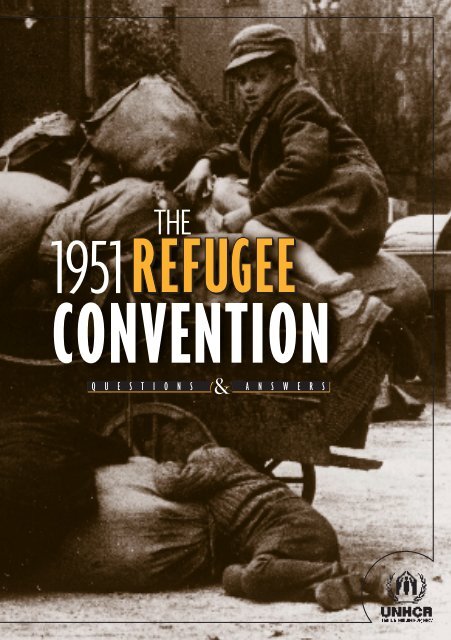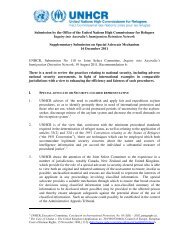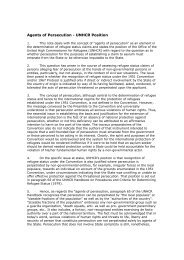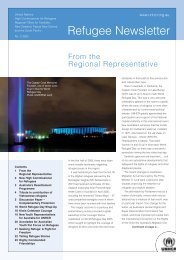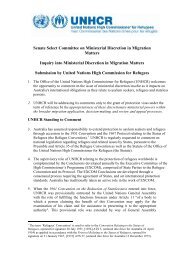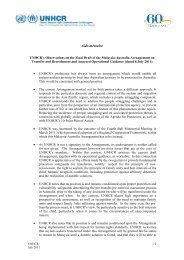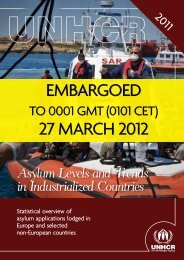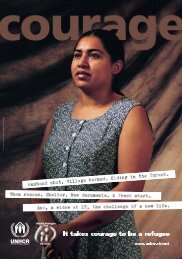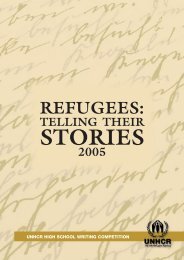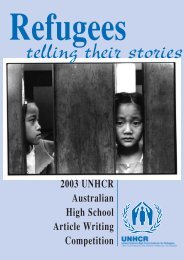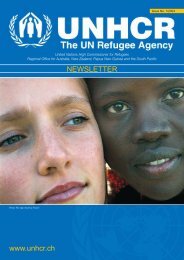convention - unhcr
convention - unhcr
convention - unhcr
You also want an ePaper? Increase the reach of your titles
YUMPU automatically turns print PDFs into web optimized ePapers that Google loves.
1951<br />
THE<br />
CONVENTION<br />
Q U E S T I O N S A N S W E R S<br />
&
A Hungarian<br />
amputee,<br />
waiting for<br />
his own chance<br />
to start a new<br />
life, waves to<br />
other asylum<br />
seekers in<br />
Austria, in 1957.
1951<br />
THE<br />
CONVENTION<br />
Q U E S T I O N S A N S W E R S<br />
&<br />
4 THE CONVENTION’ S HISTORY<br />
Cover:<br />
Young World<br />
War II refugees<br />
await help.<br />
6 THE IMPORTANCE OF THE 1951 CONVENTION<br />
8 WHAT IS PROTECTION?<br />
9 REFUGEES AND ECONOMIC MIGRANTS<br />
11 THE INTERNALLY DISPLACED<br />
15 WHAT IS TEMPORARY PROTECTION?<br />
©BPK/ DEU•1945<br />
16 ‘ ATTRACTING’ ASYLUM SEEKERS<br />
18 NON- REFUGEE PRODUCING COUNTRIES<br />
Tables<br />
10 TABLE 1<br />
Refugee numbers in the last<br />
half century.<br />
UNHCR/UN/ AUT•30415<br />
17 TABLE 2<br />
States parties to the 1951<br />
Convention and/or the 1967<br />
Protocol relating to the Status<br />
of Refugees: as at 1 st July 2003.<br />
THE 1951 REFUGEE CONVENTION<br />
3
ARNI/UN ARCHIVES/CH•2265<br />
In the beginning: The Geneva Refugee Convention was adopted on 28 July 1951 and opened for signature.<br />
?<br />
QUESTIONS<br />
ANSWERS<br />
The process of developing a body of international<br />
law, <strong>convention</strong>s and guidelines to protect refugees<br />
began in the early part of the 20 th century under the League<br />
of Nations, the predecessor of the United Nations. It culminated<br />
on 28 July 1951, when a special U.N. conference approved the<br />
Convention relating to the Status of Refugees.<br />
The Convention clearly spells out who is a refugee and the<br />
kind of legal protection, other assistance and social rights he or<br />
she should receive from states parties to the document. Equally,<br />
it defines a refugee’s obligations to host governments and certain<br />
categories of persons, such as war criminals, who do not<br />
qualify for refugee status.<br />
THE UNITED NATIONS<br />
WANTS TO “ASSURE REFUGEES<br />
THE WIDEST POSSIBLE<br />
EXERCICE OF...<br />
FUNDAMENTAL RIGHTS<br />
AND FREEDOMS.”<br />
Preamble<br />
to the 1951 Convention<br />
4<br />
THE 1951 REFUGEE CONVENTION
Several months before the Convention’s<br />
passage, the fledgling United<br />
Nations High Commissioner for<br />
Refugees had begun its work on 1<br />
January 1951. In the subsequent decades,<br />
the document has been the<br />
foundation of the agency’s efforts to<br />
help and protect more than 50 million<br />
refugees.<br />
This first instrument was limited<br />
to protecting mainly European refugees<br />
in the aftermath of World War<br />
II, but a 1967 Protocol expanded the<br />
scope of the Convention as the problem<br />
of displacement spread around<br />
the world. The original<br />
document also inspired<br />
regional instruments such as the 1969 Africa Refugee<br />
Convention and the 1984 Latin American<br />
Cartagena Declaration.<br />
“CONTRACTING STATES<br />
SHALL APPLY THE<br />
PROVISIONS OF THIS CONVENTION<br />
TO REFUGEES WITHOUT<br />
DISCRIMINATION.”<br />
A total of 145 states have acceded to one or both<br />
of the U.N. instruments (see page 17). But as the pattern<br />
of global migration changed and the number Article 3<br />
of people on the move increased dramatically in<br />
recent years, the relevance of the 1951 Convention has been<br />
called into question, especially in Europe, ironically its very<br />
birthplace.<br />
UNHCR currently helps more than 20 million people and<br />
the Convention, which has proved to be remarkably flexible in<br />
rapidly changing times, continues to be the cornerstone of<br />
refugee protection. Following are some of the most common<br />
questions about the Convention.<br />
THE 1951 REFUGEE CONVENTION 5
?<br />
&Q UESTIONS<br />
ANSWERS<br />
6<br />
Why is the Convention<br />
important?<br />
It was the first truly international<br />
agreement covering the most<br />
fundamental aspects of a refugee’s<br />
life. It spelled out a set of basic<br />
human rights which should be at<br />
least equivalent to freedoms enjoyed<br />
by foreign nationals living legally in a<br />
given country and in many cases<br />
those of citizens of that state. It<br />
recognized the international scope of<br />
refugee crises and the necessity of<br />
international cooperation, including<br />
burden sharing among states, in<br />
tackling the problem.<br />
What is contained in the<br />
1951 Convention?<br />
It defines what the term ‘refugee’<br />
means. It outlines a refugee’s rights<br />
including such things as freedom of<br />
religion and movement, the right to<br />
work, education and accessibility to<br />
travel documents, but it also<br />
underscores a refugee’s obligations to<br />
a host government. A key provision<br />
stipulates that refugees should not be<br />
returned to a country where he or<br />
she fears persecution. It also spells<br />
out people or groups of people who<br />
are not covered by the Convention.<br />
“<br />
THE 1951 REFUGEE CONVENTION<br />
WHO IS A REF<br />
Article 1 of the Convention defines<br />
a refugee as<br />
A PERSON WHO IS OUTSIDE<br />
HIS/HER COUNTRY OF<br />
NATIONALITY OR HABITUAL<br />
RESIDENCE; HAS A<br />
WELL-FOUNDED FEAR<br />
OF PERSECUTION BECAUSE OF<br />
HIS/HER RACE, RELIGION,<br />
NATIONALITY, MEMBERSHIP IN<br />
A PARTICULAR SOCIAL GROUP OR<br />
POLITICAL OPINION; AND IS<br />
UNABLE OR UNWILLING<br />
TO AVAIL HIMSELF/HERSELF OF<br />
THE PROTECTION OF THAT<br />
COUNTRY, OR TO RETURN THERE,<br />
FOR FEAR OF PERSECUTION.<br />
”<br />
What is contained<br />
in the 1967 Protocol?<br />
I<br />
t removes the geographical and<br />
time limitations written into the<br />
original Convention under which<br />
mainly Europeans involved in events<br />
occurring before 1 January 1951, could<br />
apply for refugee status.<br />
UNHCR/B. PRESS/GTM•1996
UGEE?<br />
International protection is the key to UNHCR’s efforts to help millions<br />
of refugees. A field officer helps a newly returned Guatemalan couple in<br />
1996 with their papers and documentation.
?<br />
&Q UESTIONS<br />
ANSWERS<br />
UNHCR/L.TAYLOR/DIA•GIN•2001<br />
Crises, such as those in West Africa, still scar many parts of the world,<br />
underlining the importance of the 1951 Convention.<br />
What is protection?<br />
overnments are responsible for<br />
enforcing a country’s laws. When<br />
Gthey are unable or unwilling to do<br />
so, often during a conflict or civil<br />
unrest, people whose basic human<br />
rights are threatened flee their<br />
homes, often to another country,<br />
where they may be classed as<br />
refugees and be guaranteed basic<br />
rights.<br />
Who protects refugees?<br />
Host governments are primarily<br />
responsible for protecting refugees<br />
and the 145 parties to the Convention<br />
and/or the Protocol are obliged to<br />
carry out its provisions. UNHCR<br />
maintains a ‘watching brief’,<br />
intervening if necessary to ensure<br />
bona fide refugees are granted asylum<br />
and are not forcibly returned to<br />
countries where their lives may be in<br />
danger. The agency seeks ways to<br />
help refugees restart their lives,<br />
either through local integration,<br />
voluntary return to their homeland<br />
or, if that is not possible, through<br />
resettlement in ‘third’ countries.<br />
Is the Convention still<br />
relevant for the new<br />
millennium?<br />
es. It was originally adopted to<br />
deal with the aftermath of World<br />
YWar II in Europe and growing East-<br />
West political tensions. But though<br />
the nature of conflict and migration<br />
patterns have changed in the<br />
intervening decades, the Convention<br />
has proved remarkably resilient in<br />
helping to protect more than 50<br />
million people in all types of<br />
situations. As long as persecution of<br />
individuals and groups persists, there<br />
will be a need for the Convention.<br />
STATES<br />
“SHALL NOT IMPOSE<br />
PENALTIES, ON ACCOUNT OF THEIR<br />
ILLEGAL ENTRY<br />
OR PRESENCE, ON<br />
REFUGEES.”<br />
Article 31<br />
8<br />
THE 1951 REFUGEE CONVENTION
Is the Convention<br />
meant to regulate migratory movements?<br />
STATES “SHALL ACCORD<br />
TO REFUGEES THE SAME<br />
TREATMENT AS IS ACCORDED TO<br />
NATIONALS WITH<br />
RESPECT TO ELEMENTARY<br />
EDUCATION...”<br />
Article 22<br />
o. Millions of<br />
‘economic’ and Nother migrants have<br />
taken advantage of<br />
improved<br />
communications in the<br />
last few decades to<br />
seek new lives in<br />
other, mainly western,<br />
countries. However,<br />
they should not be<br />
confused, as they<br />
sometimes are, with<br />
bona fide refugees who<br />
are fleeing lifethreatening<br />
persecution<br />
and not merely<br />
economic hardship.<br />
Modern migratory<br />
patterns can be<br />
extremely complex and<br />
contain a mix of<br />
economic migrants,<br />
genuine refugees and<br />
others. Governments<br />
face a daunting task in<br />
separating the various<br />
groupings and treating<br />
genuine refugees in the<br />
appropriate manner—<br />
through established and<br />
fair asylum procedures.<br />
UNHCR/A. HOLLMANN/CHE•22120<br />
The search for asylum is often complicated by<br />
the movement of millions of economic migrants.<br />
A Nigerian awaits his fate at Zurich airport.<br />
THE 1951 REFUGEE CONVENTION<br />
9
?<br />
&Q UESTIONS<br />
ANSWERS<br />
Number of<br />
Refugees:<br />
annual totals<br />
worldwide<br />
[ AS AT 31 DECEMBER OF<br />
EACH GIVEN YEAR ]<br />
1951 ............................ 2, 116,000<br />
1960 ........................... 1, 516,000<br />
1970 .......................... 2, 480,000<br />
1977 ........................... 4, 531,000<br />
1978 ............................ 5,070,000<br />
1979 ........................... 6, 298,000<br />
1980 .......................... 8, 439,000<br />
1981 ............................ 9, 696,000<br />
1982 ......................... 10, 300,000<br />
1983 .......................... 10, 602,000<br />
1984 ......................... 10, 710,000<br />
1985 .......................... 11, 844,000<br />
1986 ......................... 12, 614,000<br />
1987 .......................... 13, 103,000<br />
1988 ......................... 14, 319,000<br />
1989 ......................... 14, 706,000<br />
1990 ......................... 17, 370,000<br />
1991 .......................... 16, 829,000<br />
1992 ......................... 17, 802,000<br />
1993 .......................... 23, 033,000<br />
1994 ......................... 27, 419,000<br />
1995 ......................... 26, 103,000<br />
1996 ......................... 22, 729,000<br />
1997 .......................... 22, 376,000<br />
1998 ......................... 21, 460,000<br />
1999 ......................... 22, 257,000<br />
2000 ........................ 21, 814,000<br />
2001 ......................... 19, 762,000<br />
2002 ....................... 20, 557,000<br />
TABLE 1<br />
UNHCR/M. KOBAYASHI/DIA•TMP•1999<br />
UNHCR helps several million internally displaced persons, inclu<br />
safeguards for this ‘category’ of uprooted people.<br />
How are refugees<br />
and economic migrants<br />
different?<br />
An economic migrant normally<br />
leaves a country voluntarily to<br />
seek a better life. Should he or she<br />
elect to return home they would<br />
continue to receive the protection of<br />
their government. Refugees flee<br />
because of the threat of persecution<br />
and cannot return safely to their<br />
homes in the circumstances then<br />
prevailing.<br />
“EVERY REFUGEE HAS<br />
DUTIES TO THE COUNTRY IN<br />
WHICH HE/SHE FINDS<br />
HIMSELF/HERSELF...”<br />
Article 2<br />
10 THE 1951 REFUGEE CONVENTION
international debate currently<br />
underway on how this group of<br />
uprooted people can be better<br />
protected and by whom.<br />
ing these people in Timor, but there are no specific legal<br />
Does the Convention cover<br />
internally displaced persons?<br />
Not specifically. Refugees are<br />
people who have crossed an<br />
international border into a second<br />
country seeking sanctuary. Internally<br />
displaced persons (IDPs) may have<br />
fled for similar reasons, but remain<br />
within their own territory and thus<br />
are still subject to the laws of that<br />
state. In specific crises, UNHCR assists<br />
several million, but not all of the<br />
estimated 20-25 million IDPs<br />
worldwide. There is widespread<br />
Can the Convention resolve<br />
refugee problems?<br />
People become refugees, either on<br />
an individual basis or as part of<br />
a mass exodus, because of political,<br />
religious, military and other problems<br />
in their home country. The<br />
Convention was not designed to<br />
tackle these root causes, but rather<br />
to alleviate their consequences by<br />
offering victims a degree of<br />
international legal protection and<br />
other assistance and eventually to<br />
help them begin their lives anew.<br />
Protection can contribute to an<br />
overall solution, but as the number<br />
of refugees increased dramatically in<br />
recent decades, it has become clear<br />
that humanitarian work cannot act as<br />
a substitute for political action in<br />
avoiding or solving future crises.<br />
What obligations does a<br />
refugee have?<br />
R<br />
efugees are required to respect<br />
the laws and regulations of their<br />
country of asylum.<br />
THE 1951 REFUGEE CONVENTION<br />
11
?<br />
&Q UESTIONS<br />
ANSWERS<br />
Is a Convention<br />
signatory required<br />
to give permanent asylum<br />
to all refugees?<br />
The Convention does not provide<br />
automatic or permanent<br />
protection. There will be situations<br />
where refugees will integrate<br />
permanently in their country of<br />
asylum, but alternatively a person<br />
may cease to be a refugee when the<br />
basis for his or her refugee status<br />
ceases to exist. Voluntary repatriation<br />
of refugees to their country of origin<br />
is UNHCR’s ‘preferred’ solution, but<br />
only when conditions in that state<br />
permit their safe return.<br />
Voluntary repatriation, in this case to Laos, is the<br />
‘preferred’ solution to end crises.<br />
Asylum seekers should never be forcibly returned while their h<br />
UNHCR/J.M. MICAUD/DIA•LAO•1991<br />
“NO CONTRACTING STATE SHALL EXPEL OR RETURN...<br />
A REFUGEE... TO THE FRONTIERS OF TERRITORIES WHERE HIS/HER LIFE<br />
WOULD BE THREATENED...”<br />
Article 33<br />
12<br />
THE 1951 REFUGEE CONVENTION
omelands are in chaos, as Rwanda was in 1995 after that country’s infamous genocide.<br />
© S. SALGADO<br />
Can non-Convention countries refuse to admit<br />
would-be refugees?<br />
The principle of non-refoulement—<br />
the non-forcible return of people<br />
to countries where they face<br />
persecution—is part of customary<br />
international law and is binding on<br />
all states. Therefore no government<br />
should expel a person in those<br />
circumstances.<br />
THE 1951 REFUGEE CONVENTION<br />
13
Kosovar refugees<br />
arriving in the United<br />
States where they<br />
received ‘temporary’<br />
protection in 1999.
?<br />
&Q UESTIONS<br />
ANSWERS<br />
Who is not covered by the<br />
Convention?<br />
Persons who have committed<br />
crimes against peace, a war<br />
crime, crimes against humanity or a<br />
serious non-political crime outside the<br />
country of refuge.<br />
Who or what is an ‘agent<br />
of persecution’?<br />
This refers to a person or<br />
organization—governments, rebels<br />
or other groups—which force people<br />
to flee their homes. The origin of<br />
the persecution, however, should not<br />
be decisive in determining whether a<br />
person is eligible for refugee status.<br />
What is important is whether a<br />
person deserves international<br />
protection because it is not available<br />
in the country of origin.<br />
© G. ULUTUNÇOK/LAIF/LBR<br />
Gunmen or soldiers are NOT<br />
covered by the Convention.<br />
Can a soldier be a refugee?<br />
Arefugee is a civilian. Former<br />
soldiers may qualify, for instance,<br />
but a person who continues to take<br />
part in military activities cannot be<br />
considered for asylum.<br />
© BLACK STAR/L. QUINONES/KOS•1999<br />
What is ‘temporary protection’?<br />
Nations at times offer ‘temporary without any guarantee of permanent<br />
protection’ when they face a asylum. Thus ‘temporary protection’<br />
sudden mass influx of people, as<br />
can work to the advantage of both<br />
happened during the conflict in the governments and asylum seekers in<br />
former Yugoslavia in the early 1990s, specific circumstances. But it only<br />
and their regular asylum systems<br />
complements and does not substitute<br />
would be overwhelmed. In such<br />
for the wider protection measures,<br />
circumstances people can be speedily including refugee asylum, offered by<br />
admitted to safe countries, but<br />
the Convention.<br />
THE 1951 REFUGEE CONVENTION<br />
15
?<br />
&Q UESTIONS<br />
ANSWERS<br />
Are some<br />
countries,<br />
such as those in<br />
Europe, being<br />
swamped<br />
by asylum<br />
seekers?<br />
STATES “SHALL ISSUE<br />
IDENTITY PAPERS<br />
TO ANY REFUGEE IN THEIR<br />
TERRITORY...”<br />
Article 27<br />
Countries around the world,<br />
including some in Europe, believe<br />
they are being overwhelmed by<br />
asylum seekers. And while it is true<br />
that numbers have increased<br />
inexorably in the last few decades in<br />
many areas, the concerns of<br />
individual states are all relative. The<br />
bottom line is that some nations in<br />
Africa and Asia—states with far fewer<br />
economic resources than industrialized<br />
countries—sometimes<br />
host larger numbers of<br />
refugees for far longer<br />
periods of time.<br />
But does the very fact of<br />
accession to the Convention<br />
provide a ‘pull’ factor<br />
for increasing numbers of<br />
asylum seekers?<br />
No. Some states hosting the<br />
largest refugee populations are<br />
not parties to refugee instruments.<br />
Geopolitical considerations or family<br />
links play a more crucial role as far<br />
as ‘attractiveness’ of destination is<br />
concerned.<br />
! Date of entry<br />
into force:<br />
22 April 1954<br />
[Convention],<br />
4 October 1967<br />
[Protocol]<br />
! At 1 st July 2003:<br />
Total number of<br />
States Parties to<br />
the 1951<br />
Convention: 142<br />
! Total number<br />
of States Parties<br />
to the 1967<br />
Protocol: 140<br />
! States Parties<br />
to both the<br />
Convention and<br />
Protocol: 137<br />
! States Parties to<br />
one or both of<br />
these instruments:<br />
145<br />
! States Parties<br />
to the 1951<br />
Convention only:<br />
Madagascar,<br />
Monaco, Namibia,<br />
Saint Kitts and<br />
Nevis, Saint Vincent<br />
and the Grenadines<br />
! States Parties<br />
to the 1967<br />
Protocol only:<br />
Cape Verde, United<br />
States of America<br />
and Venezuela<br />
Some European countries claim they are ‘swamped’ by asylum seekers.<br />
Swiss soldiers helped process large numbers of asylum seekers, including this<br />
youngster from the Balkans, in the late 1980s.<br />
UNHCR/C. SCHÜRPF/CHE•29402<br />
16<br />
THE 1951 REFUGEE CONVENTION
States Parties<br />
to the 1951 Convention and/or<br />
the 1967 Protocol<br />
relating to the Status of Refugees<br />
[ LIST OF 145 STATES AT 1 ST JULY 2003 ]<br />
Albania<br />
Algeria<br />
Angola<br />
Antigua and Barbuda<br />
Argentina<br />
Armenia<br />
Australia<br />
Austria<br />
Azerbaijan<br />
Bahamas<br />
Belarus<br />
Belgium<br />
Belize<br />
Benin<br />
Bolivia<br />
Bosnia and Herzegovina<br />
Botswana<br />
Brazil<br />
Bulgaria<br />
Burkina Faso<br />
Burundi<br />
Cambodia<br />
Cameroon<br />
Canada<br />
Cape Verde<br />
Central African Republic<br />
Chad<br />
Chile<br />
China<br />
Colombia<br />
Congo<br />
Costa Rica<br />
Côte d’Ivoire<br />
Croatia<br />
Cyprus<br />
Czech Republic<br />
Democratic Republic<br />
of the Congo<br />
Denmark<br />
Djibouti<br />
Dominica<br />
Dominican Republic<br />
Ecuador<br />
Egypt<br />
El Salvador<br />
Equatorial Guinea<br />
Estonia<br />
Ethiopia<br />
Fiji<br />
Finland<br />
France<br />
Gabon<br />
Gambia<br />
Georgia<br />
Germany<br />
Ghana<br />
Greece<br />
Guatemala<br />
Guinea<br />
Guinea-Bissau<br />
Haiti<br />
Holy See<br />
Honduras<br />
Hungary<br />
Iceland<br />
Iran (Islamic Republic of)<br />
Ireland<br />
Israel<br />
Italy<br />
Jamaica<br />
Japan<br />
Kazakhstan<br />
Kenya<br />
Korea (Republic of)<br />
Kyrgyzstan<br />
Latvia<br />
Lesotho<br />
Liberia<br />
Liechtenstein<br />
Lithuania<br />
Luxembourg<br />
Macedonia<br />
(former Yugoslav Rep. of)<br />
Madagascar<br />
Malawi<br />
Mali<br />
Malta<br />
Mauritania<br />
Mexico<br />
Moldova<br />
Monaco<br />
Morocco<br />
Mozambique<br />
Namibia<br />
Netherlands<br />
New Zealand<br />
Nicaragua<br />
Niger<br />
Nigeria<br />
Norway<br />
Panama<br />
Papua New Guinea<br />
Paraguay<br />
Peru<br />
Philippines<br />
Poland<br />
Portugal<br />
Romania<br />
Russian Federation<br />
Rwanda<br />
Saint Kitts and Nevis<br />
Saint Vincent<br />
and the Grenadines<br />
Samoa<br />
Sao Tome and Principe<br />
Senegal<br />
Seychelles<br />
Sierra Leone<br />
Slovakia<br />
Slovenia<br />
Solomon Islands<br />
Somalia<br />
South Africa<br />
Spain<br />
Sudan<br />
Suriname<br />
Swaziland<br />
Sweden<br />
Switzerland<br />
Tajikistan<br />
Tanzania (United Republic of)<br />
Timor-Leste<br />
Togo<br />
Trinidad and Tobago<br />
Tunisia<br />
Turkey<br />
Turkmenistan<br />
Tuvalu<br />
Uganda<br />
Ukraine<br />
United Kingdom<br />
United States of America<br />
Uruguay<br />
Venezuela<br />
Yemen<br />
Yugoslavia<br />
Zambia<br />
Zimbabwe
?<br />
&Q UESTIONS<br />
ANSWERS<br />
Does accession infringe<br />
upon state sovereignty?<br />
Sovereignty is never absolute.<br />
International relations imply a<br />
reasonable and acceptable level of<br />
compromise. The refugee instruments<br />
reconcile state interests with<br />
protection. The granting of asylum,<br />
for instance, has not been<br />
incorporated into the refugee<br />
instruments and continues to be at<br />
the discretion of individual<br />
governments.<br />
Can any country be<br />
declared ‘safe’ in the sense<br />
that it cannot produce<br />
refugees?<br />
No. Even in states where there is<br />
generally no serious risk of<br />
persecution, claims by nationals must<br />
still be considered. These may be<br />
channeled through an ‘accelerated<br />
procedure’ provided that the asylum<br />
seeker is given a fair hearing.<br />
How can accession be presented to a concerned<br />
government or local population?<br />
Some domestic concerns are linked<br />
to a misreading or misconception.<br />
The Convention and Protocol are<br />
nothing more than a general legal<br />
framework on which states can build<br />
their refugee policy and obligations<br />
imposed on governments are not as<br />
constraining as often suggested. To<br />
tolerate refugees instead of giving them<br />
legal existence might create a ‘grey<br />
zone’ which could fester and turn into<br />
a serious security or political problem.<br />
18<br />
REFUGEES WILL BE ACCORDED<br />
THE SAME FREEDOM AS NATIONALS “TO<br />
PRACTICE THEIR RELIGION... AND THE RELIGIOUS<br />
EDUCATION OF THEIR CHILDREN...”<br />
Article 4<br />
THE 1951 REFUGEE CONVENTION<br />
UNHCR/S. GIRARD/MEX•1993
PUBLISHED BY:<br />
UNHCR<br />
Media Relations<br />
and Public<br />
Information Service<br />
P.O. Box 2500<br />
1211 Geneva 2<br />
Switzerland<br />
www.<strong>unhcr</strong>.ch<br />
For information<br />
and inquiries,<br />
please contact:<br />
Media Relations<br />
and Public<br />
Information Service<br />
hqpi00@<strong>unhcr</strong>.ch<br />
Going home<br />
is always the<br />
best solution<br />
for refugees<br />
worldwide.<br />
UNHCR / PI / Q&A CONVENTION / ENG 5<br />
JULY 2003


